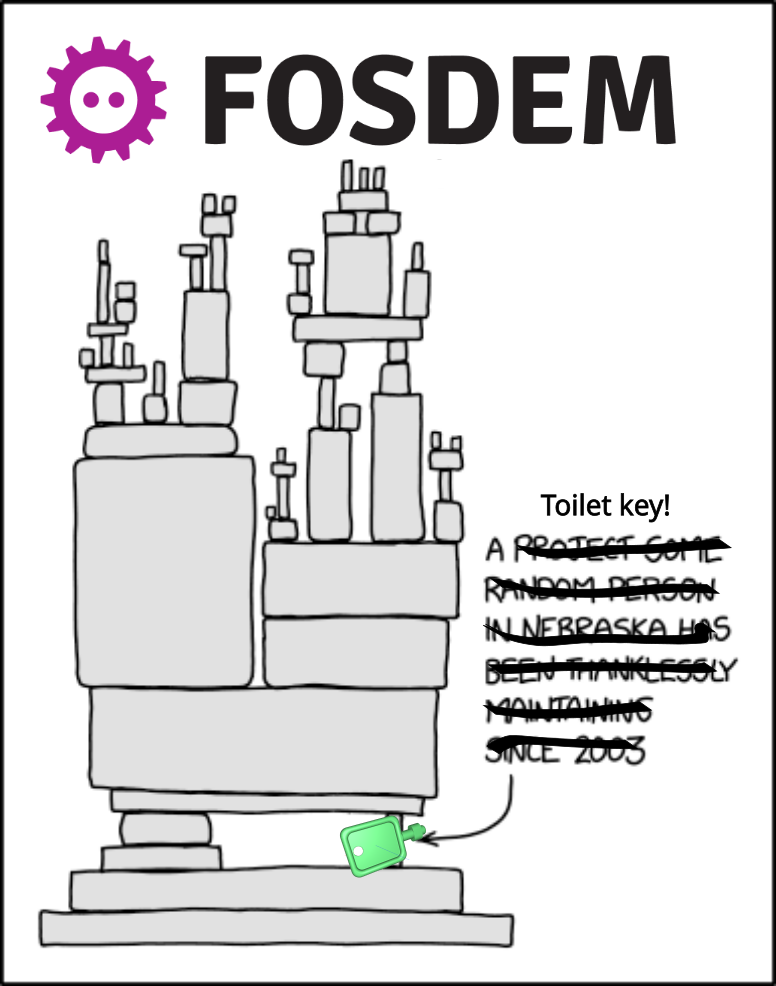My very first “design” was cord wrangler that fit the exact number of things I needed to charge and was the exact thickness for my no-name pressboard nightstand with a gap that matched an opening in the back. It was exactly what I needed.
wjrii
- 18 Posts
- 174 Comments

 2·7 months ago
2·7 months agoOh well, best of luck at Mayo!

 2·7 months ago
2·7 months agoI’m 45, and I agree with both of you. There seems to be a bimodal thing with lots of folks who are still young enough to think that screaming THE TRUTH™ to everyone they encounter will be what fixes the world, but a very large chunk of active posters who actually want to communicate seem to be a bit older. My personal theory is that the API exodus left year gathered in a lot of people who had seen previous social media sites (e.g. Digg) blow themselves up, and that by definition will skew older.

 4·7 months ago
4·7 months agoI mean, it’s unironically worth a try if you can try it risk-free. The munchies are a real thing, and many people find marijuana helps with nausea, though some find the opposite. Personally, though, smoking made me paranoid (I’m still VERY sure those two guys in Amsterdam were laughing at me, but wife is convinced otherwise), and edibles made me sleepy, not that edibles would be much of an option for you.
All that said, the only real medical advice is to keep getting medical advice. You’re clearly not dealing with something normal, so keep an eye on it for your and your family’s sake, but if it’s not killing you, then maybe you just ride this thing out. I’m of a similar age, and while I don’t have anything nearly as dramatic, dealing with the lifestyle changes forced by aging is just sort of our lot in life now.
Hang in there, FlyingSquid@lemmy.world. Rooting for you.

 3·7 months ago
3·7 months agoG2 is less sweet. Hell, that’s a whole market segment at this point, so maybe there’s something that hits your palate better. Pickle juice is probably still around somewhere too.
For the shakes, maybe look up various protein smoothie recipes if you get sick of Ensure. You can add milk or water to get the protein powder to a consistency you prefer.

 2·8 months ago
2·8 months agoLast night, I watched ‘The Conners’
There’s yer problem right there, buddy.
More seriously though, I don’t think any sitcom is obliged to be “educational.” If most of the audience laughed and didn’t find the narrative out of step with the tone of the show or the characterizations to be distractingly broad compared to earlier seasons/episodes, then it was a “good” episode of The Connors.
Now you tell me, do the Connors usually try to do the right thing and learn lessons, or are they kind of a bowdlerized “Shameless” now? I do not plan to watch enough to find out for myself.

 1·8 months ago
1·8 months agoWell shoot, now I need to make a COWABUNGA novelty keycap.

 5·8 months ago
5·8 months agoNo need to go crazy with the first one. That first step from laptop keyboard or membrane pack-in is the biggest jump you’ll ever make in typing experience. a brown-switch gamer board with the RBG turned off and some cheap Amazon “CSA” style keycaps might be all you’d ever need. Of course, even that type of thinking can lead to certain… rabbit holes.

 6·8 months ago
6·8 months agoI never truly learned to type, though I had a few weeks instruction in school, and did a few levels of Mario Teaches Typing when I was a kid. None of it really stuck, and typing remains an exercise in hand-eye coordination for me. I topped out at around 70-80 WPM if I’m composing rather than copying, but that’s been good enough for a lifetime of office jobs, and certainly for writing school essays. There is definitely a lower ceiling if you don’t get proper instruction, but simple practice is still helpful.

 26·8 months ago
26·8 months agoDrawing an imaginary factory- and they wanted kids to do this before teaching them the parts of the cell- isn’t going to help you learn what mitochondria are.
That sounds like it’s an exercise meant to get the kids thinking about a multi-faceted system existing inside a single structure, with parts that are interconnected but distinct, and will lead into a common metaphor teachers use to teach about biological cells. Not being graded means they’re not judging the kids on what they know or don’t, but want to evaluate where they are with this sort of thinking and figure out what they will focus on. Also, your kid may be smart and already know where they’re going with this, but others in the class may not. If she does, she could probably knock that out in fifteen minutes. Even if you decide that she doesn’t need to do it, I don’t think it’s stupid busy work, at least not necessarily.
Some teachers are dumb; we need too many of them and pay them too little for each and every one to be a superstar. The ones coming up with curricula and lesson plans usually aren’t, though.

 2·8 months ago
2·8 months agoAbiword is okay for now, I guess, but it’s basically a zombie, waiting for dependencies to break:
https://forums.linuxmint.com/viewtopic.php?t=412196

 4·8 months ago
4·8 months agoAll those firmwares work fine, or even better, over USB. Of course, there’s also the option to simply buy a kit. No idea if these people are legit, but the tech itself looks simple enough, a circuit board with contacts that let the linkage make a connection.

 7·8 months ago
7·8 months agoI am not quite sure I’d be ready to recommend it, but your more adventurous patrons may want to experiment. These keycaps are PBT, a cousin of polyester. They are not particularly pleasant smelling when heated or especially when burned, but they’re not as unhealthy as ABS (the other common plastic for keycaps) and certainly not as bad as the straight up poison gas that comes from PVC. I use a basic 5W blue diode laser, coat the keycap with an “infusible ink” pen from Cricut (most of their infusible products are polyester-based), put it in an alignment jig, then laser a raster image “low and slow.” My particular laser seems to do best when I do two or three passes at 2% power and 45mm/minute. The idea is to heat it roughly in line with the crafting heat presses without letting the heat spread and color in areas beyond the beam. I experimented with actually burning or engraving, and that sort of works, but (1) it’s stinky, and (2) the ash wipes away and you’re left with a mostly colorless letter-shaped indentation. The “dye sub” technique produces barely any fumes at all. There are a few people on youtube who’ve tried similar techniques, and quite a few who have used different heat or dye sources.
Aesthetically, the process was only marginally successful, though I’m optimistic about the longevity, at least compared to other low-end manufacturing techniques. I’ve been using a similar set of home-lasered keycaps for about a month with little to no wear. My jig was not as good on that set, AND I tried to center the keycap legends, meaning every fraction of a millimeter was painfully obvious. These legends didn’t end up exactly where I might have liked either, but they’re all off by the exact amount (about 1mm), so being consistent, the alignment isn’t too bad.

 6·8 months ago
6·8 months agoIt should be doable. The way these things are wired, you wouldn’t use a common. You’d instead wire a matrix with diodes to avoid ghost presses. The firmware on the arduino or RPi microcontrollers will constantly scan for keypresses. So much would depend on the exact mechanism of your typewriter, but you could find a place where a keycap moves parts in close enough proximity to make your own switches, or if some part of the mechanism presses straight down, you could just have that actuate mechanical keyboard switches.
For wireless, you’d probably want ZMK. QMK is the most famous, but ZMK supports more wireless MCUs. I use KMK, a firmware where everything is human-readable python. I understand it has some wireless support, but I’ve never looked into it.

 9·8 months ago
9·8 months agoI thought a tombstone or a boogieboard. 🤣
More seriously, things get weird when you want to go no-stabilizers but don’t want to buy a custom set of blank keycaps. This one only uses the 1.25u to 1.75u keys from a standard TKL or full size.

 7·8 months ago
7·8 months agoDoing it on the keyboard could very easily work, but I have a laser-cut jig that holds twenty-six 1u keycaps, and has one open-ended spot for anything up to maybe 3u. I considered 3D-printing the jig, but 30 minutes on the laser made more sense than 5 hours on the printer.
This plastic didn’t love my “Infusible ink” pens, so the legends are duller than the last time I did this, but the jig helped a lot with alignment, as did adjusting my ambitions and expectations. Much less disappointing to land 1mm off when you can pretend you wanted it there all along, and that is much easier to do with corner legends versus centered. :-)

 7·8 months ago
7·8 months agoThanks. Kind of a 2004 Apple and Logitech thing going. Probably need another couple of years before it’s in vogue. white filament on the printer though, so white keyboard it is.
putting another tab button on the numpad
Horizontal spreadsheet data entry, my friend. it’s probably one of the less crazy parts of this layout! Of course, ten minutes on the laser and/or 5 in the software, and I can make it any key you need. Programmable keyboards are a godsend when you’re winging it on the layout.

 4·8 months ago
4·8 months agoI am currently typing on my one and only red-switch board, and I am mis-hitting keys like a mofo, and bottoming out even harder than normal. I don’t type anywhere near correctly, but I make up for it by typing enthusiastically, and whatever the category, my favorites are always heavy.

 4·8 months ago
4·8 months agoFrom my keebtalk post, which also has more pics:
It’s early obviously, but I’m optimistic about this one. It feels pretty nice, and the Jades are almost as nice as the Navies, just missing that slight “kerchunk!” that the Navies have. The Jades are a bit snappier, and I agree that they may be ever so slightly louder, but I don’t think they dethrone my dark blue fingerbreakers.
After my last set of keycaps came out with some fairly obvious alignment issues, I rethought my jig and made a new one that could support 26 1u keys, plus one of arbitrary width. I also went with corner legends instead of centered, as that punishes a lack of accuracy much less, if you can at least get your setup repeatable. Then, I did clusters together in batches (i.e. all alphas in one run, all F keys together, etc.). The result is a much less jarring alignment situation. It would be ideal, if the plastic itself had cooperated. This PBT recipe didn’t like the infusible ink nearly as much as the DSA keycaps on my other no-stabs build. Legends are not as crisp as I’d like, and the colors are pretty muted, but the improved alignment makes this a modest victory.
Overall, I like (though not quite love) the way they came out, and the overall effect for the board, between the layout, case, and font, is a bit “Apple meets Logitech,” which may or may not be a good thing, but it’s always satisfying to wrap one of these up.



As usual, it’s more the article (and especially the headline) than the science. Here is the Abstract of the study.
It’s much more about the specific burial and the inferences that can be reasonably drawn about South America before the introduction of dogs from the north 5k years ago. It references multiple burials with non-dog canids from across time periods in S.A., including at least one from about 4k years ago, as well as many other remains scattered in with human burials. It seems to build on existing theorizing that pre-Columbian practices might have changed more slowly than post. Then there are the statistical arguments. If you occasionally find a fox in human burials, based on the number of human burials you didn’t find, you can feel pretty confident that there were more foxes buried with humans.